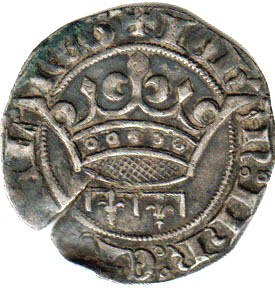Previous - old Chilean coins
Coins of Chile - catalog with values
Republic of Chile (since 1818)
Reform 1960
Escudo=100 centesimos (1960-1974)
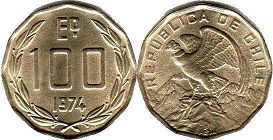
100 escudos 1974-1975
nickel-brass
23.5 mm.
5.01 grams
Edge: plain
Face value and the date inside the wreath / EQ 100 ESCUDOS / year of minting
Defiant condor on the left rock / REPÚBLICA DE CHILE
KM#202
Coin value in "UNC" ~ US$2-3
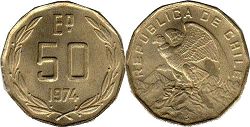
50 escudos 1974-1975
nickel-brass
21.48 mm.
4.00 grams
Edge: plain
Face value and the date inside the wreath / EQ 50 ESCUDOS / year of minting
Defiant condor on the left rock / REPÚBLICA DE CHILE
KM#201
Coin value in "UNC" ~ US$5-8
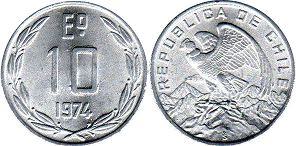
10 escudos 1974
aluminium
24.93 mm.
2.00 grams
Edge: plain
Face value and the date inside the wreath / EQ 10 ESCUDOS / year of minting
Defiant condor on the left rock / REPÚBLICA DE CHILE
KM#200
Coin value in "UNC" ~ US$0.50-1.00
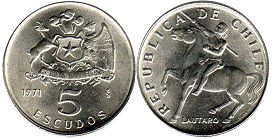
5 escudos 1971-1972
copper-nickel
23.0 mm.
4.53 grams
Edge: reeded
National coat of arms above the denomination, date on the left / 5 ESCUDOS / year of minting
Lautaro, Mapuche military leader in the Arauco War against Spain / REPÚBLICA DE CHILE / LAUTARO
KM#199
Coin value in "UNC" ~ US$1-2
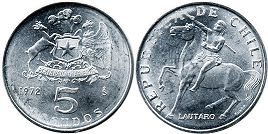
5 escudos 1972
aluminium
22.8 mm.
1.50 grams
Edge: reeded
National coat of arms above the denomination, date on the left / 5 ESCUDOS / year of minting
Lautaro, Mapuche military leader in the Arauco War against Spain / REPÚBLICA DE CHILE / LAUTARO
KM#199a
Coin value in "UNC" ~ US$1-2
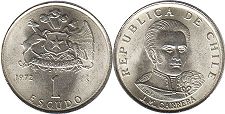
1 escudo 1971-1972
copper-nickel
18.9 mm.
2.74 grams
Edge: reeded
National coat of arms above the denomination, date on the left / 1 ESCUDO / year of minting
Bust of José Miguel Carrera 3/4 front / REPÚBLICA DE CHILE / J.M.CARRERA
KM#196
Coin value in "UNC" ~ US$0.50-1.00
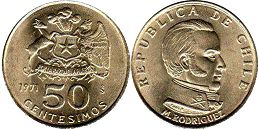
50 centesimos 1971-1972
aluminum-bronze
21.9 mm.
4.15 grams
Edge: plain
National coat of arms above the denomination, date on the left / 50 CENTESIMOS / year of minting
Bust of Manuel Rodríguez on the right / REPÚBLICA DE CHILE / M.RODRIGUEZ
KM#196
"UNC" - ~$1
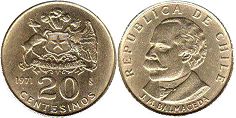
20 centesimos 1971-1972
aluminum-bronze
19.97 mm.
3.05 grams
Edge: plain
National coat of arms above the denomination, date on the left / 20 CENTESIMOS / year of minting
Bust of José Manuel Balmaceda on the left / REPÚBLICA DE CHILE / J.M.BALMACEDA
KM#195
Coin value in "UNC" ~ US$0.30-0.50
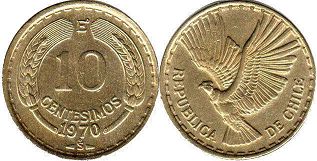
10 centesimos 1960-1970
aluminum-bronze
27.17 mm.
8.10 grams
Edge: plain
Face value before date, flank of twigs of grain / E 10 CENTESIMOS / year of minting
Flying condor / REPÚBLICA DE CHILE
KM#191
Coin value in "UNC" ~ US$0.50-1.00
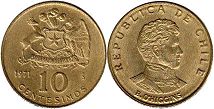
10 centesimos 1971
aluminum-bronze
18.10 mm.
2.50 grams
Edge: plain
National coat of arms above the denomination, date on the left / 10 CENTESIMOS / year of minting
Armored bust of Bernardo O'Higgins on the right / REPÚBLICA DE CHILE / B.O'HIGGINS
KM#194
Coin value in "UNC" ~ US$0.20-0.40
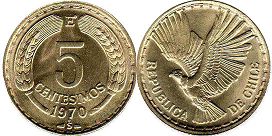
5 centesimos 1960-1971
aluminum-bronze
23.3 mm.
4.12 grams
Edge: reeded
Face value before date, flank of twigs of grain / E 5 CENTESIMOS / year of minting
Flying condor / REPÚBLICA DE CHILE
KM#190
"UNC" - ~$1
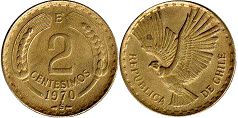
2 centesimos 1960-1970
aluminum-bronze
20.0 mm.
3.00 grams
Edge: plain
Face value before date, flank of twigs of grain / E 2 CENTESIMOS / year of minting
Flying condor / REPÚBLICA DE CHILE
KM#193
"UNC" - ~$1
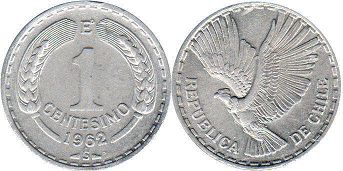
1 centesimo 1960-1963
aluminium
28.0 mm.
3.00 grams
Edge: plain
Face value before date, flank of twigs of grain / E 1 CENTESIMO / year of minting
Flying condor / REPÚBLICA DE CHILE
KM#189
Coin value in "UNC" ~ US$2-3
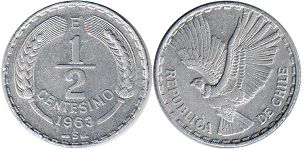
1/2 centesimo 1962-1963
aluminium
25.0 mm.
2.00 grams
Edge: plain
Face value before date, flank of twigs of grain / E 1/2 CENTESIMO / year of minting
Flying condor / REPÚBLICA DE CHILE
KM#192
Coin value in "UNC" ~ US$4-6
Reform 1975
Peso=100 centavos
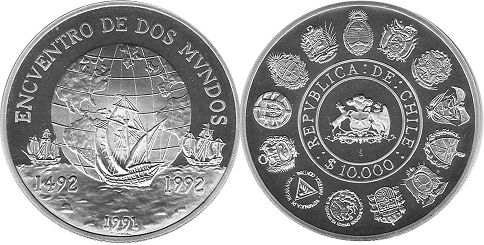
10000 pesos 1991 - 500th Anniversary of the discovery of America
silver 0.925
40.0 mm.
27.00 grams
Edge: reeded
Three dates below three ships, globe in the background / ENCVENTRO DE DOS MVNDOS / 1492 1992 / 1991
The inner circle has the coat of arms, denomination inside the outer circle, 13 coats of arms surround / $ 10.00 / REPÚBLICA DE CHILE
KM#230
"PROOF" ~ US$40-60
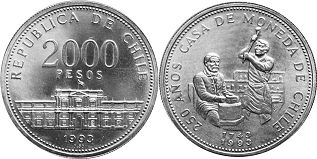
2000 pesos 1993 - 250th Anniversary of the Mint
silver 0.500
26.2 mm.
8.20 grams
Edge: reeded
Face value, the Mint, year / 2000 PESOS / REPÚBLICA DE CHILE / 1993
Metal workers / 250 AÑOS CASA DE MONEDA DE CHILE / 1743 1993
KM#233
Coin value in "UNC" ~ US$25-35
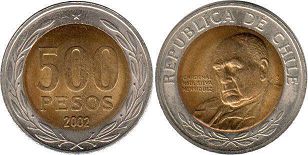
500 pesos since 2001
bimetallic: core of aluminum-bronze in ring of copper-nickel-zinc
26.0 mm.
6.50 grams
Edge: reeded
Face value, date and National emblem surround the set two branches of laurel / 500 PESOS / year of minting
Figure of Cardinal Raúl Silva Henríquez / REPÚBLICA DE CHILE / CARDINAL RAUL SILVA HENRIQUES
KM#235
"UNC" - ~$1
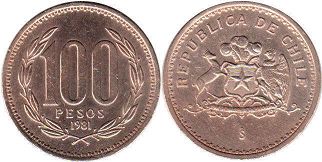
100 pesos 1981-1987 - Date wide with pointed "9"
aluminium-bronze
27.0 mm.
9.00 grams
Edge: with the phrase: POR LA RAZON O LA FUERZA
Face value on the date inside the wreath of laurels / 100 PESOS / year of minting
National emblem / REPÚBLICA DE CHILE
KM#226.1
"XF" ~ US$2-4
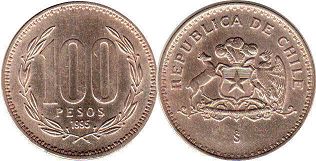
100 pesos 1989-2000 - Date narrow with curve "9"
aluminium-bronze
27.0 mm.
9.00 grams
Edge: with the phrase: POR LA RAZON O LA FUERZA
Face value on the date inside the wreath of laurels / 100 PESOS / year of minting
National emblem / REPÚBLICA DE CHILE
KM#219.1
"UNC" - ~$1
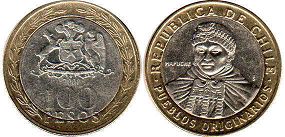
100 pesos since 2001
bimetallic: core of copper-nickel-zinc in ring of aluminum-bronze
23.5 mm.
7.58 grams
Edge: divided into alternate sixths in smooth and striated
Face value, date and National emblem surround the set two branches of laurel / 100 PESOS / year of minting
Mapuche woman / REPÚBLICA DE CHILE; PUEBLOS ORIGINARIOS; MAPUCHE
KM#236
Coin value in "UNC" ~ US$0.30-0.80
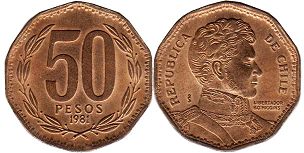
50 pesos 1981-1987 - Date wide
aluminium-bronze
25.0 mm.
7.00 grams
Edge: chain
Face value on the date inside the wreath of laurels / 50 PESOS / year of minting
Armored bust right / REPÚBLICA DE CHILE / LIBERTADOR B.O'HIGGINS
KM#219.1
"UNC" - $1-2
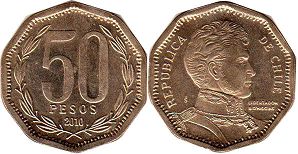
50 pesos since 1988 - Date narrow
aluminium-bronze
25.0 mm.
7.00 grams
Edge: chain
Face value on the date inside the wreath of laurels / 50 PESOS / year of minting
Armored bust right / REPÚBLICA DE CHILE / LIBERTADOR B.O'HIGGINS
KM#219.2
Coin value in "UNC" ~ US$0.20-0.40
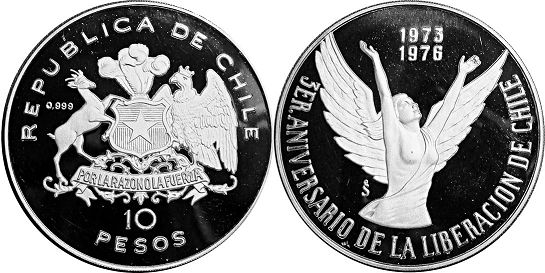
10 pesos 1976 - 3rd Anniversary of the new government
silver 0.999
45.0 mm.
45.00 grams
Edge: reeded
Face value and the National Shield / 10 PESOS / REPÚBLICA DE CHILE / 0,999
Winged figure with raised arms, broken chain at wrists / 3ER. ANIVERSARIO DE LA LIBERCION DE CHILE / 1973 1976
KM#211
"PROOF" ~ US$650-750
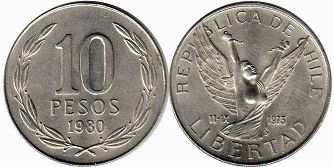
10 pesos 1976-1980
copper-nickel
28.0 mm.
8.90 grams
Edge: reeded
Face value and the date inside the wreath / 10 PESOS / year of minting
Winged figure with raised arms, broken chain at wrists / REPÚBLICA DE CHILE / LIBERTAD / 11-IX 1973
KM#210
Coin value in "UNC" ~ US$2-4

10 pesos 1981-1987 - Date wide
aluminium-bronze
21.0 mm.
3.50 grams
Edge: reeded
Face value and the date inside the wreath / 10 PESOS / year of minting
Winged figure with raised arms, broken chain at wrists / REPÚBLICA DE CHILE / LIBERTAD / 11-IX 1973
KM#215.1
"UNC" - ~$1
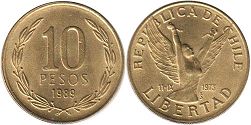
10 pesos 1988-1989 - Date narrow
aluminium-bronze
21.0 mm.
3.50 grams
Edge: reeded
Face value and the date inside the wreath / 10 PESOS / year of minting
Winged figure with raised arms, broken chain at wrists / REPÚBLICA DE CHILE / LIBERTAD / 11-IX 1973
KM#218.2
"UNC" - ~$1
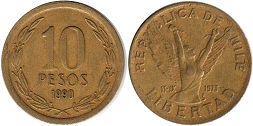
10 pesos 1990
aluminium-bronze
21.0 mm.
3.50 grams
Edge: reeded
Face value and the date inside the wreath / 10 PESOS / year of minting
Winged figure with raised arms, broken chain at wrists / REPÚBLICA DE CHILE / LIBERTAD / 11-IX 1973
KM#218.3
Coin value in "UNC" ~ US$1-2
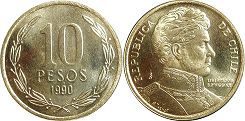
10 pesos 1990 - wide border
aluminium-bronze
21.0 mm.
3.50 grams
Edge: reeded
Face value and the date inside the wreath / 10 PESOS / year of minting
Armored bust right / REPÚBLICA DE CHILE / LIBERTADOR B.O'HIGGINS
KM#228.1
Coin value in "UNC" ~ US$8-12
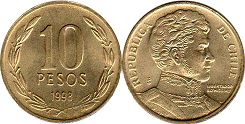
10 pesos since 1990 - narrow border
aluminium-bronze
21.0 mm.
3.50 grams
Edge: reeded
Face value and the date inside the wreath / 10 PESOS / year of minting
Armored bust right / REPÚBLICA DE CHILE / LIBERTADOR B.O'HIGGINS
KM#228.2
Coin value in "UNC" ~ US$0.20-0.50
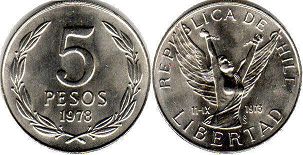
5 pesos 1976-1980
copper-nickel
26.0 mm.
6.60 grams
Edge: reeded
Face value on the date inside the wreath of laurels / 5 PESOS / year of minting
Winged figure with raised arms, broken chain at wrists / REPÚBLICA DE CHILE / LIBERTAD / 11-IX 1973
KM#209
Coin value in "UNC" ~ US$2-4
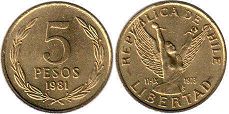
5 pesos 1981-1987 - Date wide
aluminium-bronze
19.0 mm.
2.80 grams
Edge: plain
Face value on the date inside the wreath of laurels / 5 PESOS / year of minting
Winged figure with raised arms, broken chain at wrists / REPÚBLICA DE CHILE / LIBERTAD / 11-IX 1973
KM#217.1
"UNC" - ~$1
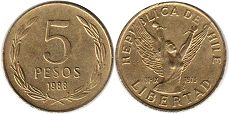
5 pesos 1988-1990 - Date narrow
aluminium-bronze
19.0 mm.
2.80 grams
Edge: plain
Face value on the date inside the wreath of laurels / 5 PESOS / year of minting
Winged figure with raised arms, broken chain at wrists / REPÚBLICA DE CHILE / LIBERTAD / 11-IX 1973
KM#217.2
"UNC" - ~$1
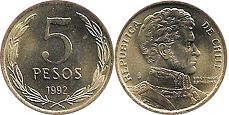
5 pesos 1990-1992
aluminium-bronze
19.0 mm.
2.80 grams
Edge: plain
Face value on the date inside the wreath of laurels / 5 PESOS / year of minting
Armored bust right / REPÚBLICA DE CHILE / LIBERTADOR B.O'HIGGINS
KM#229
Coin value in "UNC" ~ US$2-5

5 pesos 1992-2015
aluminium-bronze
15.5 mm.
2.20 grams
Edge: plain
Face value on the date inside the wreath of laurels / 5 PESOS / year of minting
Armored bust right / REPÚBLICA DE CHILE / LIBERTADOR B.O'HIGGINS
KM#232
Coin value in "UNC" ~ US$0.40-0.80
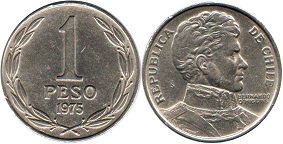
1 peso 1975
copper-nickel
24.0 mm.
5.00 grams
Edge: reeded
Face value on the date inside the wreath of laurels / 1 PESO / year of minting
Armored bust right / REPÚBLICA DE CHILE / BERNARDO O'HIGGINS
KM#207
Coin value in "XF" - ~$1
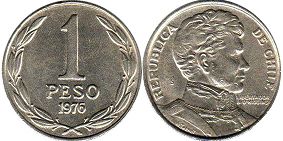
1 peso 1976-1977
copper-nickel
24.0 mm.
5.11 grams
Edge: reeded
Face value on the date inside the wreath of laurels / 1 PESO / year of minting
Armored bust right / REPÚBLICA DE CHILE / LIBERTADOR O'HIGGINS
KM#208
Coin value in "XF" - ~$1
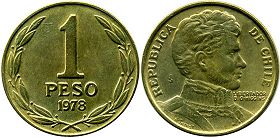
1 peso 1978-1979
aluminium-bronze
24.0 mm.
5.00 grams
Edge: reeded
Face value on the date inside the wreath of laurels / 1 PESO / year of minting
Armored bust right / REPÚBLICA DE CHILE / LIBERTADOR O'HIGGINS
KM#208a
Coin value in "XF" - ~$1
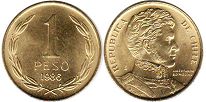
1 peso 1981-1987 - Date wide
aluminium-bronze
17.0 mm.
2.00 grams
Edge: plain
Face value on the date inside the wreath of laurels / 1 PESO / year of minting
Armored bust right / REPÚBLICA DE CHILE / LIBERTADOR O'HIGGINS
KM#216.1
Coin value in "UNC" ~ US$0.50-1.00
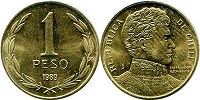
1 peso 1988-1991 - Date narrow
aluminium-bronze
17.0 mm.
2.00 grams
Edge: plain
Face value on the date inside the wreath of laurels / 1 PESO / year of minting
Armored bust right / REPÚBLICA DE CHILE / LIBERTADOR O'HIGGINS
KM#216.2
Coin value in "UNC" ~ US$0.30-0.60

1 peso 1992-2015 - Date wide
aluminium
15.5 mm.
0.70 grams
Edge: plain
Face value on the date inside the wreath of laurels / 1 PESO / year of minting
Armored bust right / REPÚBLICA DE CHILE / LIBERTADOR O'HIGGINS
KM#231
Coin value in "UNC" ~ US$0.30-0.60

1 peso 1993-2002 - Date narrow
aluminium
15.5 mm.
0.70 grams
Edge: plain
Face value on the date inside the wreath of laurels / 1 PESO / year of minting
Armored bust right / REPÚBLICA DE CHILE / LIBERTADOR O'HIGGINS
KM#231
Coin value in "UNC" ~ US$0.30-0.60
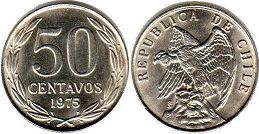
50 centavos 1975-1977
copper-nickel
22.17 mm.
4.13 grams
Edge: reeded
Face value on the date inside the wreath of laurels / 50 CENTAVOS / year of minting
Defiant condor on the left rock / REPÚBLICA DE CHILE
KM#206
Coin value in "XF" ~ US$2-3
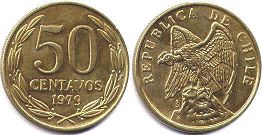
50 centavos 1978-1979
aluminium-bronze
22.06 mm.
4.00 grams
Edge: reeded
Face value on the date inside the wreath of laurels / 50 CENTAVOS / year of minting
Defiant condor on the left rock / REPÚBLICA DE CHILE
KM#206a
Coin value in "UNC" ~ US$1-2
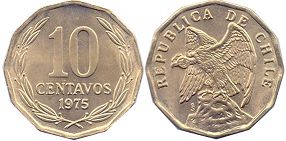
10 centavos 1975-1976
aluminium-bronze
23.75 mm.
5.01 grams
Edge: plain
Face value on the date inside the wreath of laurels / 10 CENTAVOS / year of minting
Defiant condor on the left rock / REPÚBLICA DE CHILE
KM#205
Coin value in "UNC" ~ US$5-7
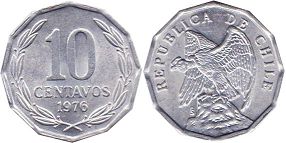
10 centavos 1976-1979
aluminium
23.75 mm.
2.05 grams
Edge: plain
Face value on the date inside the wreath of laurels / 10 CENTAVOS / year of minting
Defiant condor on the left rock / REPÚBLICA DE CHILE
KM#205a
"UNC" - ~$1
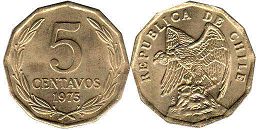
5 centavos 1975-1976
aluminium-bronze
21.6 mm.
3.95 grams
Edge: plain
Face value on the date inside the wreath of laurels / 5 CENTAVOS / year of minting
Defiant condor on the left rock / REPÚBLICA DE CHILE
KM#204
Coin value in "UNC" ~ US$1-2
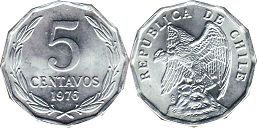
5 centavos 1976
aluminium
21.6 mm.
1.50 grams
Edge: plain
Face value on the date inside the wreath of laurels / 5 CENTAVOS / year of minting
Defiant condor on the left rock / REPÚBLICA DE CHILE
KM#204a
"UNC" - ~$1
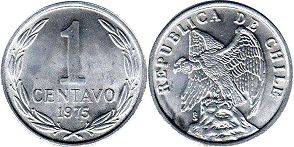
1 centavo 1975
aluminium
24.9 mm.
2.00 grams
Edge: plain
Face value on the date inside the wreath of laurels / 1 CENTAVO / year of minting
Defiant condor on the left rock / REPÚBLICA DE CHILE
KM#203
Coin value in "UNC" ~ US$0.50-1.00
Costs of Chile coins in this catalog approximate and indicated specifically for the coin shown in the picture.
I do not buy or sell coins - this is just a catalog.


